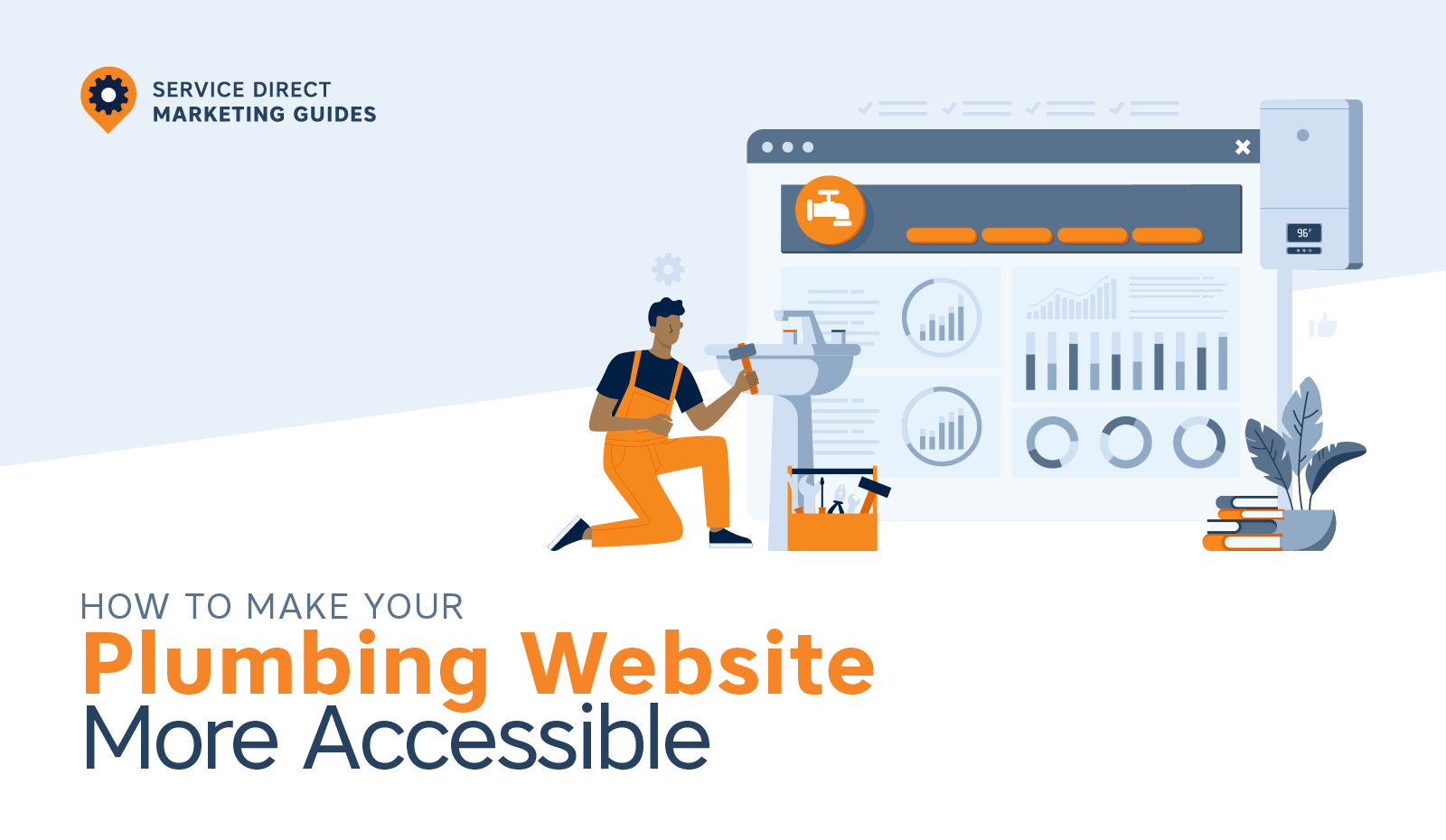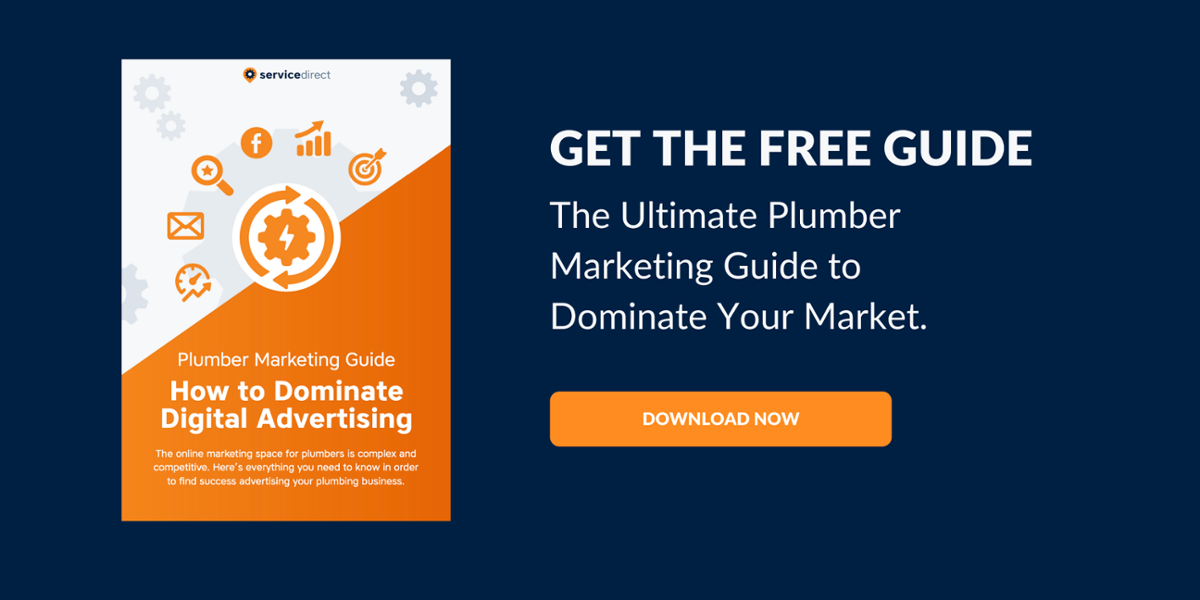How To Make Your Plumbing Website More Accessible
In today’s digital world, having a website that everyone can use is crucial. As a plumber, your goal is to help all customers, including making your website easy to navigate for everyone, including people with disabilities.
An accessible website broadens your customer base and improves your online presence. It is also a legal requirement per the Americans with Disabilities Act.
In this blog post, we will go over simple steps to make your plumbing website more accessible, ensuring visitors can use it easily and effectively.

Website accessibility means using optimization features that allow everyone to view your plumber website, including people with disabilities.
Accessibility is a crucial element in online plumbing marketing. It ensures that all potential customers can access and benefit from your services. Plus, it helps search engines promote your website.
For small businesses, focusing on accessibility can be the key to meeting your plumber marketing goals. An accessible website broadens your audience, improves user experience, and enhances your online presence.
By making your website accessible, you show that you care about all customers, which can build trust and loyalty.
The Importance of Accessible Content for Plumbers
Businesses, including plumbing companies, have a responsibility to ensure their websites are accessible to everyone. There are a number of organizations that have created guidelines to promote digital inclusivity.
For instance, the Web Content Accessibility Guidelines provide a comprehensive framework to make web content accessible to all users, regardless of their abilities. The principles of accessibility are known as POUR—Perceivable, Operable, Understandable, and Robust.

Meeting these website accessibility standards helps you comply with potential legal obligations and broadens your audience. This is especially important for plumbers who want to expand their customer base and enhance their marketing strategy. An accessible website can attract more visitors and convert them into loyal customers.
Accessibility Challenges
Creating an accessible website involves understanding the challenges that people with disabilities may face.
Here are some common issues:
-
Visual Impairments: People with visual impairments may struggle with small font sizes, poor color contrast, and images without descriptive text.
-
Hearing Impairments: Users who are hard of hearing or deaf may not be able to understand video content without captions.
-
Mobility Impairments: Some users may find it difficult to navigate a website using a mouse.
-
Cognitive Impairments: People with disabilities may find complex navigation and dense text difficult to understand.
By recognizing these challenges, you can create a more inclusive and user-friendly website for all visitors. This not only improves the user experience but also helps you reach a wider audience, ultimately supporting your marketing goals.
Necessary Accessibility Changes for Plumbers
Making your plumbing website accessible is crucial. These changes ensure that all potential customers, including those with disabilities, can easily navigate and use your site. Accessibility broadens your audience and demonstrates your commitment to serving everyone.
Screen Reader Compatability
Screen readers are tools that people with visual impairments use to read text aloud. They are not just used to read paragraphs or bullet points but also describe images with appropriate text.

To make your site compatible with screen readers, consider the following tips:
-
Use Alt Text for Images: Provide descriptive alt text for all images. This allows screen readers to describe the images to users who cannot see them. For example, instead of using “image1.jpg,” use “Plumber fixing a sink.”
-
Label Headings Properly: Use heading tags (H1, H2, H3, etc.) to organize your content. This helps screen readers understand the structure of your page. Your main title should be an H1, subheadings should be H2, and so on.
-
Avoid Vague Anchor Text: Use descriptive anchor text for links instead of vague terms like “click here.” For example, use “learn more about our plumbing services” instead.
-
Reduct Cluttered Text: Pages packed with long sentences and complex words can be difficult to process through a screen reader. Break up text with bullet points to reduce busyness.
Following these practices ensures that screen readers can navigate and read your website effectively, improving the experience for visually impaired users.
Structured Headers
Organizing your content with clear and consistent headers, spaces, and breaks makes it easier to read, especially for those in the neurodivergent community.
Using structured headers helps users quickly find and understand the information they need. Ensure your website follows a logical hierarchy, with main topics as H1 headings and subtopics as H2 or H3 headings.
Clear Language
Plumbing services are something that everyone needs. You want to ensure your website is just as accessible to potential customers as your services.
Using clear and precise language is important to make your content accessible to everyone, regardless of their educational level. Avoid using jargon or complex words.
Tools like the Hemingway app and Grammarly can help you simplify your language, ensuring your content is easy to read and understand.
Text Visibility
Good text visibility is essential for creating an accessible website. When text is clear and easy to read, it enhances the overall user experience, making it more inclusive for everyone.
This includes:
-
Users with Visual Impairments: High contrast, large fonts, and simple layouts help users with low vision or color blindness read and navigate your website.
-
Older Adults: Many older adults experience age-related vision decline. Clear, high-contrast text ensures they can comfortably read your content.
-
Users with Cognitive Disabilities: Simple fonts, consistent layouts, and organized content help users with cognitive disabilities process information more easily.
By focusing on text visibility, you can create a more accessible and user-friendly website for all visitors, ensuring that everyone can access and benefit from your services. This commitment to accessibility broadens your audience and demonstrates your dedication to inclusivity and customer care.
Video Considerations
Videos can be a great alternative to written content and can enhance accessibility. By providing visual and auditory stimuli, videos can be easier to process and understand than text.
Additionally, videos can be paused and replayed, allowing users to absorb the information at their own pace. Complete the video accessibility circle by providing text transcripts, so that people can choose how they want to digest content.
It’s essential to ensure that your media player supports closed captioning for those who are hard of hearing. While auto-generated captions are getting better and better thanks to AI and other tools, it’s always a good idea to check that the captions are accurate.
Color
Consider the background color on your site to assist those with visual impairments and color blindness.

Use high-contrast color schemes and avoid relying solely on color to convey information. Ensure that all text is readable against the background and that interactive elements are easily distinguishable. Some tools can help ensure your color scheme is accessible.
Keep in mind that the colors of your website not only affect accessibility but also impact the mood of visitors. For example, blue is a calming color that instills trust and reliability. Plumbers who use blue on their website might find that potential customers feel an innate sense of confidence from the outset.
By implementing these accessibility changes, you can make your plumbing website more inclusive and user-friendly. A website accessibility checker can help you reach a broader audience and meet your marketing goals.
How to make Your SIte Mobile Friendly
Making your website mobile-friendly is essential for improving accessibility. With the majority of consumers using their mobile devices to search for small businesses, it’s a critical step in reaching as many people as possible.

Here are some tips to help plumbers optimize their websites for mobile use:
-
Optimize JavaScript: Ensure that JavaScript enhances the user experience without slowing down the site. Test your site on various mobile devices to make sure that JavaScript functions properly.
-
Avoid Unplayable Content: Ensure all content, including videos and animations, is playable on mobile devices. Avoid using formats that are not supported on mobile, such as Flash.
-
Single Column Layout: Design your content in a single-column layout instead of horizontal passages. This makes it easier to scroll and read on small screens.
-
Responsive Design: Use responsive design techniques to ensure your website automatically adjusts to fit different screen sizes and orientations.
-
Touch-Friendly Buttons: Make sure buttons and links are large enough to be easily tapped with a finger. This improves navigation and usability for mobile users.
The Importance of Inclusive Content
Creating inclusive content is crucial for making your website accessible to a diverse audience. The ultimate goal of accessibility is to reach broader audiences, regardless of their identity or experiences, and inclusive content helps achieve this goal.
To improve inclusivity, use language that is respectful and free from bias. Avoid overly gendered terms and use gender-neutral language whenever possible. Don’t make assumptions about your audience’s abilities, experiences, or backgrounds. Instead, aim to create content that is welcoming and understandable for everyone.
Write content that is relevant and relatable to a wide range of people. This includes considering different cultural, social, and personal experiences. When discussing specific groups or identities, research and use the terminology preferred by those communities.
By focusing on inclusive content, you can ensure that your website is welcoming to all visitors, helping you reach a wider audience and demonstrating your commitment to accessibility and inclusivity.
In Conclusion
Making your plumbing website accessible is not just about following legal requirements; it’s about ensuring that all potential customers, including those with disabilities, can easily navigate and use your site.
By implementing the changes discussed in this blog—such as enhancing text visibility, using clear language, and creating inclusive content—you can significantly improve the user experience for everyone.
improve the user experience for everyone.
FAQs About Website Accessibility for Plumbers
What Does Website Accessibility Mean for a Plumbing Business?
Website accessibility means ensuring that your plumbing website can be used easily by everyone, including those with disabilities. This includes making your site navigable by screen readers, easily readable, and straightforward to interact with, regardless of a user's physical capabilities.
How Can I Tell If My Website Is Currently Accessible?
You can use various online tools and resources, such as the Web Accessibility Evaluation Tool (WAVE) or Google's Lighthouse, to audit your website for accessibility issues.
What Quick Changes Can I Make to Improve My Website's Accessibility?
Some quick changes include adding alt text to all images, ensuring sufficient text contrast for easy reading, using larger, simpler fonts, and organizing your site's structure with clear headings.
How Does Making My Website Accessible Help With Mobile Friendliness?
Many accessibility practices, such as straightforward navigation and responsive design, naturally improve the mobile experience. An accessible site often translates to a more user-friendly site on mobile devices, where users may have different interaction modes and limitations.
How Often Should I Review My Plumbing Website for Accessibility Updates?
It's a good practice to review your website for accessibility at least once a year or whenever you make significant updates. Regular reviews ensure compliance with the latest accessibility standards.
What Is the Best Way to Accessible Content Creation?
When creating content, aim for clarity and simplicity. Use plain language, avoid jargon, and provide clear instructions. Also, consider adding captions or transcripts for audio and video content to cater to those with hearing impairments.




